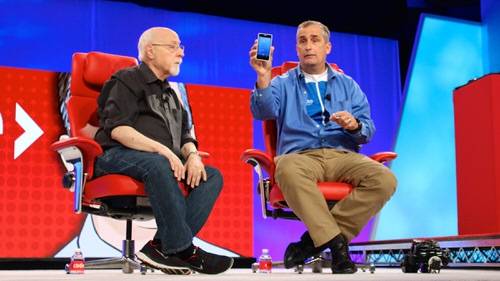

ReadWriteBody is an ongoing series where ReadWrite covers networked fitness and the quantified self.
And then there was the time when Intel CEO Brian Krzanich started unbuttoning his shirt on stage.
The boss of the giant chipmaker stopped several buttons short of any risqué moves, but he wanted to show Recode’s Walt Mossberg, who was interviewing him at the Code Conference earlier this week in Los Angeles, what he was wearing underneath: a bicycling jersey wired up with steel threads and sensors that could read his heart rate and other vital signs.
Wiring Up What We Wear
Call it the Internet of Threads: Intel wants to get inside clothing, one of many new markets it’s exploring.
The Smart Shirt prototype Krzanich wore used an Edison chip to process signals off of the jersey, made by Intel partner AIQ Smart Clothing. Edison is Intel’s big bet on the wearables market, an all-in-one chipset that inventors can take off the shelf to start building devices with connectivity without having to put all of the silicon parts together themselves.
Krzanich also showed an app that picked up his heart rate from the shirt.
“I’m relatively calm for being up on stage,” Krzanich said. “Uh oh, now my heart rate’s going up.”

Intel is developing a new technology called Gossamer, a combination of hardware and software that’s especially good at processing heart-rate data. That could be useful: As I’ve found, the quality of heart-rate data varies wildly from device to device and app to app, and different companies take different approaches to handling the variations people see.
Basis, a smartwatch maker Intel recently acquired, tries to smooth out heart-rate variations to get a useful reading over a long period of time, at the cost of moment-to-moment accuracy. Under Armour’s Armour39 tries to capture the spikes elite athletes can generate when they launch right into an intense workout.
A Struggle To Fit Into Clothes
The challenge Intel will face is signing up wearable inventors, who so far have preferred to tweak every last bit of their hardware and software to extend battery life and get the right experience for users.
The right decisions if you’re targeting runners and cyclists might not work out for people who prefer to work out inside a gym. And devices that target the athletic demographic may not work well for other markets. Krzanich brought up the example of providing Smart Shirts to elderly people living in nursing homes, to better monitor their health.
Fashion being fashion, it’s unlikely that a device targeted for the geriatric set will appeal to avid runners (like Krzanich himself).
I asked Stéphane Marceau, CEO of OMsignal, a maker of smart shirts whose first products are coming out this summer, what he thought of Intel’s move. Would OMsignal put Intel inside its shirts one day? He shared these thoughts:
Hey, we just source the best components in order to deliver the best Biometric Smartwear to our consumers. So far, the only way to effectively harness biosignal “from skin to insights” and to deliver a seamless consumer product has been for us to develop our own architecture/software and source a variety of specialized components. For now, we are very full stack. However, we are totally open to working with leading partners like Intel and others in the future.
Smart clothing for consumers is a new category. It involves a product that is hard to do well and involves a lot of seamless integration (even across different mediums). It is probably not atypical for a new category to start with a very “vertically integrated” value chain and then eventually modularize, to gradually open and then partly disaggregate.
So Intel may have a shot. But right now, with wearable clothing as a very nascent market, it may be too early. There aren’t enough customers—either in the fashion business or as consumers—for smart clothing to be a business like PCs, with one kind of chip inside most devices.
And most people are very cost-sensitive in buying clothes. So if tech-enabled apparel does develop into a mass market, it’s not clear there will be big profits in it. In Krzanich’s hunt for big new markets, this may not be a good fit.
Feature photo via AIQ Smart Clothing; photo of Walt Mossberg and Brian Krzanich by Owen Thomas for ReadWrite









